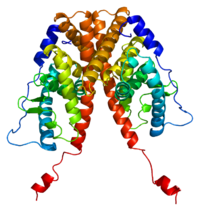
Photo from wikipedia
Markers of cancer stemness predispose patients to tumor aggressiveness, drug and immunotherapy resistance, relapse, and metastasis. DDX17 is a cofactor of the Drosha-DGCR8 complex in miRNA biogenesis and transcriptional coactivator… Click to show full abstract
Markers of cancer stemness predispose patients to tumor aggressiveness, drug and immunotherapy resistance, relapse, and metastasis. DDX17 is a cofactor of the Drosha-DGCR8 complex in miRNA biogenesis and transcriptional coactivator and has been associated with cancer stem-like properties. However, the precise mechanism by which DDX17 controls cancer stem-like features remains elusive. Here, we show that the E3 ligase HectH9 mediated K63-polyubiquitination of DDX17 under hypoxia to control stem-like properties and tumor-initiating capabilities. Polyubiquitinated DDX17 disassociated from the Drosha-DGCR8 complex, leading to decreased biogenesis of anti-stemness miRNAs. Increased association of polyubiquitinated DDX17 with p300-YAP resulted in histone 3 lysine 56 (H3K56) acetylation proximal to stemness-related genes and their subsequent transcriptional activation. High expression of HectH9 and six stemness-related genes (BMI1, SOX2, OCT4, NANOG, NOTCH1, and NOTCH2) predicted poor survival in patients with head and neck squamous cell carcinoma and lung adenocarcinoma. Our findings demonstrate that concerted regulation of miRNA biogenesis and histone modifications through posttranslational modification of DDX17 underlies many cancer stem-like features. Inhibition of DDX17 ubiquitination may serve as a new therapeutic venue for cancer treatment. SIGNIFICANCE: Hypoxia-induced polyubiquitination of DDX17 controls its dissociation from the pri-miRNA-Drosha-DCGR8 complex to reduce anti-stemness miRNA biogenesis and association with YAP and p300 to enhance transcription of stemness-related genes.
Journal Title: Cancer research
Year Published: 2019
Link to full text (if available)
Share on Social Media: Sign Up to like & get
recommendations!